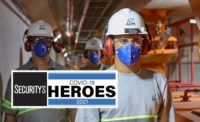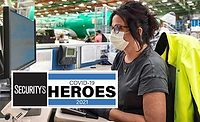Managing access in higher education during COVID-19
Security professionals in higher education can implement a number of strategies to ensure safety and security without hindering the learning environment.






With COVID-19 still among us, many campuses are shut down, partially shut down or limiting access. While the risk of unwanted access in a campus setting has always been a security risk, campuses are also dealing with additional threats and risks based on COVID-19, along with the current social unrest and uncertain political climate in the U.S. and around the world. Though visitor and access management is a priority in higher education, an even stronger emphasis is being placed on protocols, tactics, training and systems that can help colleges and universities keep students, employees and locations safe and secure while adjusting to the new normal of learning during the pandemic. Managing access protects campuses and people, and right now, that also translates to minimizing unnecessary spread of the virus. With this new reality of stacked risks, there are some best practices emerging.
“Many colleges and universities have the same concerns and types of threats. Networking and talking with peers on a regular basis is so important because if they are seeing a trend, chances are we’ll be seeing it soon too,” says Jim Kurtz, Director of Public Safety at Macalester College, St. Paul, Minn. Kurtz came to the private sector after 30 years in law enforcement (10 of those years as Chief of Police in Mound, Minn.).
He says that the biggest security concerns that can partially be mitigated by managing access are COVID-19, social unrest, and uninvited guests or burglaries. “Obviously, COVID-19 and its risks are the biggest hot button right now because along with its impact on the community, country and state, my department is responsible for medical response and our campus’ isolation process and procedures,” Kurtz says. “So the biggest focus becomes how do we work safely. We have done a significant amount of training for our public safety officers on how to safely and properly respond to potential COVID-19 medical calls.”
Gregory Richter, Director of Safety and Security at a multi-campus university in Florida, adds, “Though the COVID-19 situation is our biggest concern right now, it never negates our everyday safety and security concerns.” Richter spent 35 years in the public sector including the Federal Bureau of Investigation, Metro Dade-Miami PD and the Palm Beach County Sheriff’s Office, before moving to the private sector. He says that unwanted guests are always a concern at large campuses where access and visitor management can be a challenge, but there are simple steps, protocols and systems that educational institutions can put in place to manage and control access.
Half of the battle, he says, is being sure staff follow through with the protocols. “We have to be right 100% of the time, and someone that wants to cause harm only has to be right once. If someone who is up to no good shows up, it only takes one. In our business an ounce of prevention is worth a ton of care,” he says.
Let’s take a deeper look at how Kurtz and Richter are using access management and other tactics to respond to COVID-19, along with everyday threats on their campuses.
Limiting Access
“We’ve put protocols in place for [COVID-19] that include questionnaires for visitors, temperature checks and colored wrist bands to help us with visitor access,” says Richter. The colored wristbands allow public safety staff to quickly identify who should or shouldn’t be on campus at any given time. “We’ve also limited entrances, and limited the amount of personnel we have on campus,” he adds. Though, he says, the campus had implemented limited access points prior to COVID-19, the campus has closed and limited entrances even further to more tightly control access.
Part of the way Richter and his team ensure limited access is by having personnel stationed at access points at each campus, taking names, vehicle information and reason for visit. For offices, classrooms and other buildings, electronic access control systems and traditional door locks keep uninvited visitors under control. “It’s so important to be able to know where people are,” he says.
Though Macalester College is a private institution, it has always been community friendly and remained largely open to its surrounding community. Being along public transit routes and right in the center of St. Paul, a closed campus has not been a big part of its strategy for dealing with uninvited guests. But, Kurtz says, with the pandemic and current climate of social unrest, the campus has had to place a greater emphasis on its access control systems and on education about limiting access to buildings within the campus.
“Due to the virus we’ve had to close, or restrict the use of many of our buildings, such as the library and athletic facilities. Our card access system has allowed us to give staff and students access to those facilities, while also being able to control access to the general public,” he says.
Another important tool for managing access Kurtz says, is training security staff on protocols, procedures and friendly enforcement, along with educating employees and students on tailgating, letting people into a building without a card, mask requirements and social distancing. “We are trying to prevent the spread of the virus throughout campus. Overall, our students and staff have accepted and supported our Mac Stays Safer Community Commitment on COVID-19 behavior and accountability. But, there are still instances when we have to educate and do some friendly enforcement,” Kurtz says.
Technology Tools
While many campus security experts say procedures, training and education are perhaps the most important tools for their job, electronic systems play a role in helping security professionals manage access and response, particularly across multi-building, multi-campus locations.
Richter says that when it comes to managing access, communication and simple two-way radios, for example, are a key component for public safety departments in higher education institutions around the world.
In addition, access control systems are a vital tool for campuses to limit access as well as have a trail of information to help with incident response or investigations. “Using card access for building management is huge,” Kurtz says. “In a college setting, we use it every day.” He says that his team has relied on the college’s access control system significantly during COVID-19 to limit building access and make sure that only necessary users are granted access.
Real World Training
Both Kurtz and Richter agree that training should go beyond public safety staff, to college faculty, administrative staff and students helping to mitigate risk and gain compliance with new protocols. “With the virus, we have said from the beginning that it’s everyone’s responsibility for us all to stay safe,” Kurtz says. One way in which Macalester has reached students and staff is through a 12-minute campus training video on COVID-19 response and procedures. In order for students and staff to have a working ID card for the campus’ access control system, they must watch the video. If they don’t, their access cards get turned off. “It’s a way for us to control that access and ensure everyone’s on the same page. It has worked out well,” he shares.
When it comes to other access and security risks, continued training is necessary to keep campus security staff and volunteers educated and alert while minimizing complacency. Many universities utilize volunteers of students, staff and/or faculty to help beef up campus response initiatives. Richter’s campus response team is made up of volunteers, many with an interest in law enforcement or security in some way. “We train them in conjunction with our security staff, and they help us maintain a proactive security-oriented environment. You can’t sit on your hands, you have to constantly be aware of what the security threats are and continually evolve and develop your security,” Richter says. He says that live training opportunities allow everyone to learn proper procedures and protocols, while remaining engaged and being prepared for unknown circumstances.
“Training helps retain employees. You have the situations you know will happen that you train for, such as unwanted guests or slips and falls, but you also have to train for those situations that may never happen, such as a fire, an explosion or an active shooter,” Richter says.
Kurtz says that his team involves and recruits faculty or staff that are in close contact with students or are seen as role models such as coaches, athletic directors or counselors, to reinforce response procedures. “If you can incorporate within your plan people within the organization that students trust and respect, then you have the best chance for de-escalating or preventing an incident. It’s so important to plan ahead, do tabletop exercises and practice. It can’t just be public safety – everyone needs to feel confident and prepared so we can have unified responses,” he says.
Looking for a reprint of this article?
From high-res PDFs to custom plaques, order your copy today!









